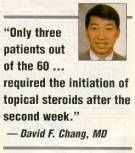 OCULAR
SURGERY NEWS Vol.17,
No.17, Page 8-9 September 1, 1999
OCULAR
SURGERY NEWS Vol.17,
No.17, Page 8-9 September 1, 1999  OCULAR
SURGERY NEWS Vol.17,
No.17, Page 8-9 September 1, 1999
OCULAR
SURGERY NEWS Vol.17,
No.17, Page 8-9 September 1, 1999
Drug delivery implant advances in clinical trials
Oculex reached phase 3 with promising drug delivery technology
SEATTLE - While perioperative anti-inflammatory medication for cataract surgery continues to be the standard of care, the very short duration, compliance issues and inconvenience of drugs continue to present drawbacks.
 David
F. Chang, MD, spoke at the American Society of Cataract and Refractive Surgery
about an implantable polymer implant that can deliver drugs continuously inside
the eye.
David
F. Chang, MD, spoke at the American Society of Cataract and Refractive Surgery
about an implantable polymer implant that can deliver drugs continuously inside
the eye.
Oculex Pharmaceuticals of Sunnyvale, Calif., developed a sustained release, intraocular drug delivery system. The device is 1 mm long and is made of a biodegradable polymer that can be inserted into the anterior or posterior chamber following surgery.
Any drug bound to this polymer gradually is released at a programmed rate as the polymer is dissolving. Depending on the formulation, this can be released over a period of 1 week, or over as long a period as 1 year, he said.
Implant advantagesOculex's first product, Surodex, contains the same amount of drug that is contained in a single drop of topical Decadron (dexamethasone sodium phosphate, Merck). Rabbit studies show that this system achieves a sustained level of steroid in the anterior chamber for about 1 week.
Two human clinical trials investigating the safety and efficacy of this system have been completed. Following a small phase 1 U.S. study showing no adverse problems, a phase 2 clinical trial enrolled 90 patients at four study sites in a randomized, double-masked, placebo controlled trial in which the intraocular drug delivery system (DDS) was compared with no treatment at all.
They were randomized following uncomplicated surgery by a 2:1 ratio into a treatment group that received the dexamethasone DDS, or a control group that either had no treatment or a placebo delivery particle. The steroid DDS was compared with no treatment because, at the time of the study, rimexolone was the only steroid that was Food and Drug Administration approved for postop inflammation, on the basis of a controlled trial.
In order to mask the postoperative slit lamp examiners, who were separate individuals from the surgeons, either the drug-containing or the placebo-delivery particles were hidden behind the iris in the posterior chamber.
None of the study patients could receive any perioperative anti-inflammatory medication until postoperative day 3, at which time the masked slit lamp examiner could prescribe topical anti-inflammatories, such as steroids, for any inflammatories, such as steroids, for any inflammation that was failing to improve. This was called rescue medication.
The majority of the patients receiving the dexamethasone DDS, or 88%, required no additional rescue medication throughout the 2-month period, Dr. Chang said. This was in contrast to the control group, where the majority, or 83%, did require topical steroids.
"Only three patients out of the 60 in the treated group required the initiation of topical steroids after the second week, at a time when the intraocular level would have been presumably non-detectable," Dr. Chang said. "This suggests that rebound inflammation was not a frequent occurrence with this treatment."
Dexamethasone DDS also was superior to no treatment in suppressing anterior chamber cell and flare, as assessed by masked slit lamp examiners all throughout the 2-month period. Many of the control group patients were on topical steroids at this point.
Head to head studyDexamethasone DDS was directly compared against topical Decadron administered four times per day for 4 weeks in a separate, randomized, double-masked study of 60 cataract patients conducted by Dr. Tan, et al, in Singapore.
This study looked at anterior chamber flare, as measured with a laser flare meter. The dexamethasone DDS group had less flare than the topical steroid group throughout the 3-month postoperative period, and these results were statistically significant at postop day 4, 8 and 15, he said.
There were no complications or adverse effects attributable to the delivery system in either of these two studies, Dr. Chang said. Specifically there were no instances of elevated intraocular pressure persisting beyond the first postoperative day. The extent to which the short duration of drug delivery may decrease the incidence of steroid induced ocular hypertension will continue to be of interest.
The U.S. phase 3 completed enrollment September 1998 and now includes 305 patients at nine sites in two study arms. The first arm compares the implant to placebo in a randomized, double-masked trial of 241 patients, while the second arm is an open-label study or the DDS in 64 patients to accumulate more safety and efficacy data.
"The dexamethasone intraocular drug delivery system appears to be a promising and possibly more efficacious alternative to topical steroids following uncomplicated cataract surgery," Dr. Chang said. "By reducing or eliminating the need for patient instruction and patient compliance, this system of drug delivery may turn out to be a more patient-friendly, surgeon-friendly and cost effective alternative.
by Ryan DuBosar
OSN Staff Writer